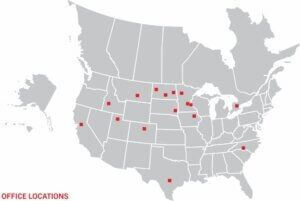Ulteig Energy & Infrastructure Podcast: On the Road Again – The Impact of COVID-19 on State Highway Systems
September 14, 2020
Steve Harelson, chief engineer with CDOT, shares lesson learned – so far – from the COVID-19 pandemic and what the future of transportation may look like.
It’s safe to say that no one expected the size or the depth of the impact that the COVID-19 virus has had on the United States.
Beyond the health story, the virus has affected every aspect of day-to-day life – our workplaces, our education system, how we shop, and how we socialize, play, and worship.
All of these impacts have not gone unnoticed in the world of those who plan, build and maintain our nation’s roads, bridges, and public transit systems.
In episode 5 of the Ulteig Energy and Infrastructure Podcast series, Aaron Lauinger, Market Director–Transportation and Water for Ulteig, is joined by Steve Harelson, chief engineer for the Colorado Department of Transportation (CDOT) and Andi Schmid, Ulteig’s Transportation Team Lead to discuss the impact of COVID-19 on the nation’s transportation system, and specifically in Colorado.
While news reports hint at a possible vaccine sometime next year, the virus continues to rage across the country, in particular, the southern half of the country. Scientists worry about a second wave of infections in late fall and throughout the winter months coinciding with flu and cold season.
With more than 30 years in civil engineering, of which, the past 18 have been with CDOT, Harelson, like many of his peers working for other state DOT offices, is facing a slew of challenges related to the COVID-19 pandemic, from worries about funding shortfalls (drop in revenues from gas tax collections) to preparing projects for shovel-ready funding should Congress pass a much-anticipated infrastructure bill.
“We were just preparing for our annual road construction season when COVID-19 hit,” says Harelson.
In partnership with the state’s Department of Public Health, CDOT had to figure out how to keep employees and contractors working on CDOT projects safe during road construction. And, like many other organizations, the department also had to protect employees working indoors to ensure that planning, scheduling and collaboration with vendors could continue without interruption.
“We had to discourage our own employees from carpooling,” Harelson says.
Throughout the interview, Aaron and Andi touched on a number of issues with Harrelson that would likely concern others involved in the building and maintaining of the nation’s transportation infrastructure. Key highlights include:
Increased Productivity – If there has been a silver lining to the COVID-19 pandemic, it’s that transportation departments across the country are completing their planned road construction projects in record time this year. For CDOT, the first two months of the pandemic resulted in record low traffic volumes, which allowed a number of road construction projects to be completed well ahead of schedule – including projects scheduled to be worked on at night, which could be completed during the day time.
Preparing for a Budget Shortfall – Harelson is anticipating a decline in the department’s budget as a result of lower gas tax and toll revenues being collected due to lower traffic volume. “We plan for the worst and hope for the best,” Harelson says.
Planning – Harelson says CDOT has a 10-year plan for transportation infrastructure projects and a 4-year plan. The department is prioritizing both plans to get as many projects shovel-ready in the event Congress passes an infrastructure stimulus. Aaron noted the importance of having shovel-ready projects – in 2009, when Congress passed a similar infrastructure stimulus (American Recovery and Reinvestment Act of 2009). States only had four months to spend their allocated funds.
Anticipate the Future of Transportation – Harelson notes that lower traffic volume is not the only reason gas tax collections are falling. The wide use of more gas efficient vehicles is lowering collections. This will be followed in the years to come by a growth in electric vehicles. The question is how do you make up for that loss in revenue, which will be needed to build a network of quick charging stations for a growing fleet of electric vehicles, as well as other transportation enhancements, including public transit options.
Smart Infrastructure – The key to building better, smarter transportation infrastructure depends upon reliability, says Harelson. For example, people want to know that they can reliability get to the airport without getting hung up in traffic. “We need a network of open roadways to ensure the proper flow through our system,” Harelson says. And, he noted, transportation departments need to anticipate a future of connected vehicles.
 Launched in March 2020, the Ulteig Energy & Infrastructure Podcast spans Ulteig’s Lifeline Sectors® of Power, Renewables, Transportation and Water. It offers thought-provoking and engaging conversations with key industry stakeholders on technology, innovation, policy and funding. Click here to listen to the current podcast or download it through Apple, Google Play, or Spotify.
Launched in March 2020, the Ulteig Energy & Infrastructure Podcast spans Ulteig’s Lifeline Sectors® of Power, Renewables, Transportation and Water. It offers thought-provoking and engaging conversations with key industry stakeholders on technology, innovation, policy and funding. Click here to listen to the current podcast or download it through Apple, Google Play, or Spotify.
WHAT MAKES ULTEIG DIFFERENT?
From global energy producers to locally funded cities and private developers to government agencies, the clients we serve encompass a broad range of relationships and projects. Find out why Ulteig is a leader in the engineering industry.
Contact Us
